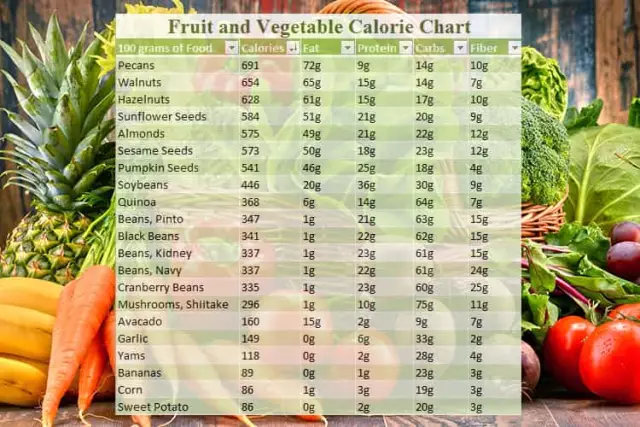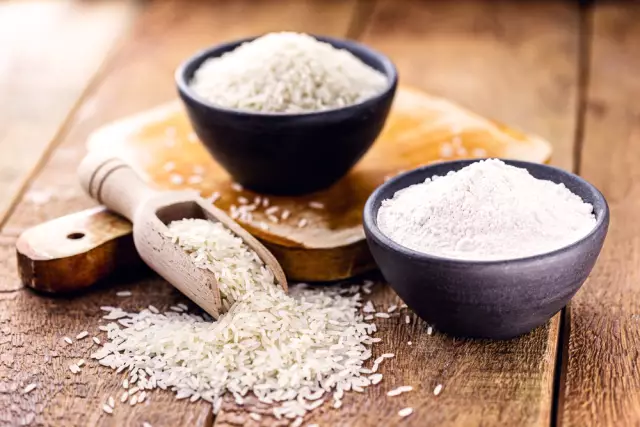- Author Rachel Wainwright [email protected].
- Public 2023-12-15 07:39.
- Last modified 2025-11-02 20:14.
Pumpkin
Pumpkin is a representative of plants belonging to the pumpkin family. The pumpkin can be annual or perennial. The leaves of the pumpkin are large, hairy or hard-rough, its branches are creeping or clinging. During flowering, the plant is covered with large flowers, white or yellow. The fruit of the pumpkin is large, often reaches a large size: from 2 to 9 kg.
The ratio of BJU in the product

Source: depositphotos.com How to burn 26 kcal?
| Walking | 7 minutes |
| Jogging | 3 min. |
| Swimming | 2 minutes. |
| A bike | 4 minutes |
| Aerobics | 5 minutes. |
| Household chores | 9 minutes |
In total, there are about 10 wild types of pumpkin in nature. They grow in the warm climates of many countries. Pumpkin is cultivated not only for eating fruits, but also for decorative purposes
Composition, benefits of pumpkin and calories
Pumpkin consists of an upper shell (peel), directly pulp and seeds. The peel or peel takes up about 17% of the total weight of the pumpkin, and the pulp - up to 75%, while the seeds take no more than 11%.
The benefits of pumpkin for the human body can hardly be overestimated. It is a natural source of a mass of nutrients and microelements, aromatic pumpkin pulp contains many important vitamins. Pumpkin has an amazing taste and has a beneficial effect on the human body. Useful properties of pumpkin are represented by a wide list of substances that make up its composition:
- Vitamins;
- Ash;
- Starch;
- Mono - and disaccharides;
- Water;
- Organic acids;
- Valuable proteins;
- Alimentary fiber.
The list of vitamins in the composition represents the special benefits of pumpkin and its properties to have a beneficial effect on health:
- B vitamins;
- Vitamin PP (niacin equivalent);
- Vitamin E;
- Vitamin C;
- Vitamin A;
- Beta carotene;
- Vitamin PP;
- Vitamin K;
- Vitamin T.
B vitamins give pumpkin the properties of a sedative (sedative). So, pumpkin contains the following vitamins of this group:
- B9 (folic acid);
- B6 (pyridoxine);
- B5 (pantothenic acid);
- B2 (riboflavin);
- B1 (thiamine).
These vitamins have a beneficial effect on the nervous system and calm it down. Thanks to this, a person's sleep improves, attention and memory are activated.
Vitamin C, which is especially valuable for the body in the autumn-winter period, in combination with B vitamins, helps to overcome fatigue and causeless irritability. It is especially useful to drink juice from fresh pumpkin during depression, stress and nervous exhaustion. Vitamin C will help get rid of acne, strengthen nails and hair. Vitamins A and E are excellent remedies for the prevention of early wrinkles and aging.
Also pumpkin is useful, due to the content of carotene and rare vitamin K. The significant content of carotene determines the exceptional benefits of pumpkin. So, this substance has a positive effect on vision, serves as the prevention of cancer. Carotene has long been recognized as a natural antibiotic, so its benefits are very significant for the body. Vitamin K contributes to good blood clotting. The presence of this vitamin is an exceptional property of pumpkin, because no other vegetable contains vitamin K.
Pumpkin's ability to help digestion and prevent obesity is due to its vitamin T content.
An important property of pumpkin is the content of all kinds of minerals in it:
- Fluorine;
- Manganese;
- Copper;
- Iodine;
- Zinc;
- Iron;
- Sulfur;
- Chlorine;
- Phosphorus;
- Potassium;
- Sodium;
- Magnesium;
- Calcium.
The presence of copper, phosphorus and iron in the composition of pumpkin helps to normalize the process of hematopoiesis. Therefore, for the prevention of anemia and atherosclerosis, you need to eat this product. In addition, pumpkin has a mild laxative effect, thereby restoring the work of the gastrointestinal tract.
The beneficial properties of pumpkin are also confirmed by the unique combination of potassium and magnesium in it. It is this combination of trace elements that promotes the elimination of excess fluid from the body. Thus, the benefits of pumpkin are especially relevant for those who have diseases of the urinary system.
The benefits of pumpkin are also the fact that among all kinds of vegetables, it is the champion in iron content. The benefits of pumpkin are also presented in the content of valuable proteins. There are even more of these substances in a vegetable than in chicken or quail eggs.
Along with the numerous properties of pumpkin and its benefits, it contains very few calories. So, the calorie content of pumpkin is only 22 kcal.
Eating
Due to the tough rind, some housewives refuse pumpkin, as it is difficult to process. But this inconvenience fades into the background if you think about what benefits pumpkin has for human health.
Pumpkin pulp can be used to squeeze out juices, prepare fresh salads and desserts from it. The vegetable becomes slightly less nutritious after heat treatment. So, pumpkin can be boiled, stewed, baked. You can also fry this vegetable, but there will be little benefit in this case.
For medicinal purposes, the most ideal way to extract all the possible beneficial properties of pumpkin is to squeeze out fresh juice.
Pumpkin juice and pulp are indicated for use by people with the following health conditions:
- Cardiovascular diseases;
- Puffiness;
- Thrombosis;
- Thrombophlebitis;
- Liver disease;
- Bladder problems;
- Insomnia.
The beneficial properties of pumpkin have a beneficial effect on health when used externally. So, pumpkin pulp gruel can heal many skin diseases:
- Eczema;
- Burns;
- Acne (acne);
- Ulcers;
- Fistulas;
- Inflammation;
- Allergic rashes.
Men are especially advised to include this vegetable in their diet, since pumpkin has been scientifically proven to support sexual function and potency at a high level. This property of pumpkin lies in its seeds. In addition, pumpkin seeds are a well-known anthelmintic agent. That is why pumpkin seeds should be given to children for the prevention of worms.
This product is well absorbed by the stomach. That is why, using the many beneficial properties of pumpkin, many diets (medicinal and for weight loss) are compiled. The benefits of pumpkin lie not only in its ability to control weight, but also in the fact that it can remove excess cholesterol from the body.
The benefits of pumpkin and its properties are used not only as a nutritious food and medicine, but also for cosmetic purposes. Excellent masks for the skin are made from it. Surprisingly, pumpkin masks and rubbing the skin with its juice are shown for all skin types.

Contraindications and harm from eating pumpkin
Along with the enormous benefits of pumpkin and its properties that provide a healing effect, it has its own contraindications. So, pumpkin will not benefit those who have the following health problems:
- Peptic ulcer;
- Gastritis with low acidity;
- Diabetes;
- Violation of the acid-base balance in the body.
In addition, doctors do not recommend using pumpkin for food for persons with chronic diseases of the gastrointestinal tract, during exacerbations.
YouTube video related to the article:
Found a mistake in the text? Select it and press Ctrl + Enter.






